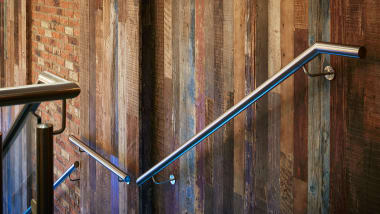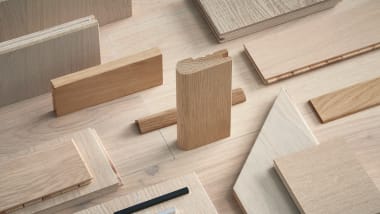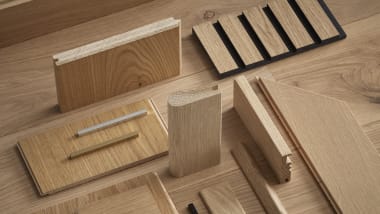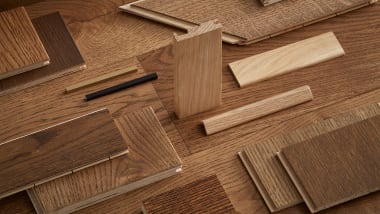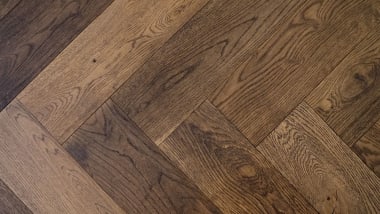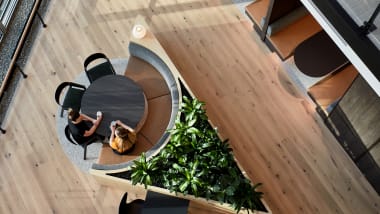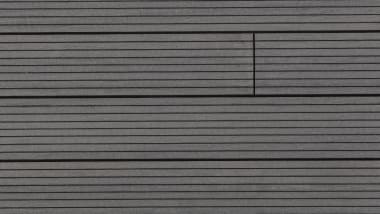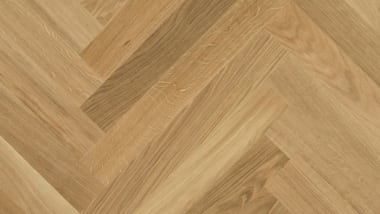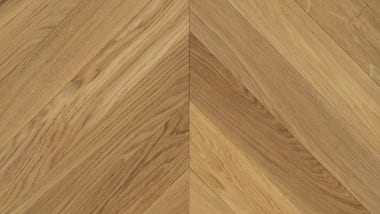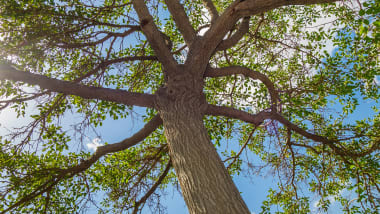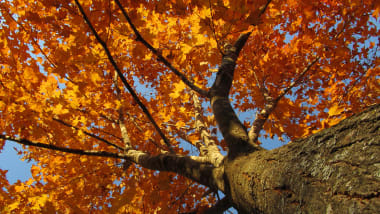Wood Flooring Species
When it comes to floors, some wood flooring species work harder than others.
The more you know about the unique characteristics of wood and its source, the better equipped you are to choose a wood flooring species which will fulfil your specific individual requirements. Floors, walls and ceilings made of wood are truly unique for, like fingerprints, every single tree features a unique grain pattern.
Strictly speaking, the classification hard wood does not actually mean that the wood is hard, it means that it comes from a leaf bearing tree; soft wood come from a cone bearing tree. In fact, some leaf bearing trees produce very soft wood, whilst some cone bearing trees have very hard woods. Hardness is actually measured by the Janka test, which was designed primarily to ascertain the suitability of a given wood for use in flooring. It measures the resistance of the wood to denting and wear by measuring the force, in pounds, required to embed an 11.28mm steel ball into the wood to a depth of half of the ball’s diameter
Ash
Ash is a member of the Fraxinus genus of which there are around 60 different species, including the olive and lilac families, growing throughout Europe, North America, north Africa and many parts of Asia. European Ash is a large, deciduous tree which grows freely throughout the continent. It is resilient and grows rapidly and, as such, was an important resource for smallholders and farmers who would often coppice the trees on a ten-year cycle to provide a sustainable source of timber for fuel, building and woodworking.
The colour of ash wood ranges from creamy white through light brown, whilst the heart wood may be a darker olive-brown. The timber is hard (white ash measures 1320 on the Janka scale), tough, highly flexible, shock-resistant and also resistant to splitting, all of which makes ash suitable for solid or engineered woods floors. Solid ash flooring is strong and flexible; engineered ash flooring benefits from the same attributes; both are prized for their colour and attractive, coarse, open, fairly straight grain which resembles that of oak.
Bamboo
Providing arguably the most ‘green’, eco-friendly flooring solution, bamboo is not really a timber at all, but a grass. As a self-generating, renewable resource which grows to full maturity within five years, sequesters up to 70% more carbon than a hardwood forest and incurs both minimal waste and minimal pollution in harvesting and production, products made from bamboo are now surging in popularity.
Bamboo is an attractive alternative for flooring because of its physical similarities to hardwoods. It is strong, durable and resistant to insects and moisture. Traditional bamboo flooring uses thin bamboo stems cut as flat as possible and in this state is of a similar hardness to oak; in the West, however, the terms solid bamboo flooring or engineered bamboo flooring are somewhat misleading since all the available flooring is made from processed bamboo.
The Janka hardness test measures resistance to denting and wear, primarily to determine the suitability of a species for use in flooring. The hardest processed bamboo is strand woven bamboo which shows a Janka hardness of 3000 pounds-force – greater than that exhibited by virtually all the common hardwoods and similar to that of ebony.
Beech
Beech, Latin name Fagus, is a genus of ten species of deciduous trees native to temperate Europe, Asia and North America. Beech logs burn extremely cleanly so they are used to dry the malts used in some German smoked beers as well as for smoking cheeses. Beech wood is tough, strong and heavy with tiny pores and large, conspicuous medullary rays, similar in appearance to maple; it is widely used for furniture framing, carcass construction, flooring and engineering purposes. Engineered and solid beech flooring is pale in colour with a warm tone and even texture. Beech measures 1300 on the Janka scale.
Black Walnut
Native to eastern North America the black walnut (Juglans nigra) is a large deciduous tree which is prized for both its high quality wood and its edible fruit (the nut). The nutmeat is similar to that of the milder-tasting English walnut although it is primarily used in more expensive baked goods since it is quite difficult to extract. The hard black walnut shell is also used commercially for cleansing and polishing in industries as diverse as cosmetics and oil well drilling. Black walnut plantings can be made to produce timber, nuts or both timber and nuts.
Black walnut wood is particularly valuable, indeed in some areas of the US it is the most valuable commercial timber species, and forestry officials are often called upon to track down walnut poachers! The wood itself is strong, hard and durable without being excessively heavy. It is easily split and worked and takes finishes well, but it is prized primarily for its grain and colour which ranges from creamy-white in the sapwood to the dark chocolate colour of its heartwood which, when air dried, takes on a rich, purplish hue. The grain in the trunk is straight, becoming wavy towards the roots; stumps are often dug out and used as a source of highly figured veneer. European walnut is lighter in colour and slightly finer in texture and was popular in all types of fine cabinet work, particularly during the eighteenth century.
Solid black walnut flooring is dense and hard (1010 on the Janka scale), grainy and well-marked with complex rings and knots which make it truly distinctive. Since it utilises a layer of the same hardwood bonded to other wood layers under high pressure, engineered black walnut flooring is equally as tough and attractive.
Cherry
A member of the Prunus genus, as are plums, peaches, apricots and almonds, cherry trees are probably better known for the cultivars which have been specifically developed for either their ornamental blossom or their fruit. Cherry wood is a specialized timber coming from the larger species, usually the wild cherry, and is often used for more traditional-style furniture. It is a moderately hard (950 on the Janka scale), strong, closed grain wood which resists warping and checking and is easy to carve and polish. Engineered and solid cherry flooring is noted for its colour, brown with a hint of pink or dark red; the colour will intensify with age.
Elm
The genus Ulmus in the plant family Ulmaceae originated in what is now central Asia about 20 million years ago, flourished and spread over most of the northern hemisphere. Elms are components of many kinds of natural forests and during the nineteenth and early twentieth centuries they were also planted widely as ornamental street, lawn and park trees. In the past few decades many elms throughout Europe and North America have succumbed to Dutch elm disease, a beetle-dispersed fungus; horticulturists have now developed disease-resistant types and new plantings are taking place.
Elm wood has a fairly coarse, open, interlocking grain which allows it to bend quite easily without splitting, hence its historical popularity as ships’ keels. It is also resistant to decay when permanently wet so hollowed elm trunks were often used as water pipes in medieval Europe, native Americans used it to fashion canoes, and elm was used as piers in the construction of the original London Bridge.
Imbuya
Ocotea porosa is a species of the Lauraceae family and has several common names, including various spellings of imbuya and the simpler Brazilian walnut. In fact, imbuya is not related to the walnut family, nor does it produce nuts, but it is found in the subtropical rain forests of southern Brazil where it is an important commercial species for high-end furniture, veneers and as flooring.
Engineered imuya flooring is particularly handsome, the timber showing a medium to high lustre and striking variegated grain; colours range from yellow-olive to a dark, chocolate-brown.

